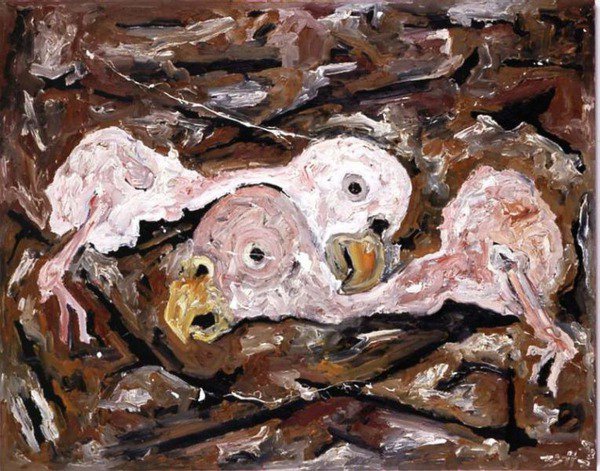Werner Buttner
dal 4/4/2013 al 21/9/2013
Segnalato da
4/4/2013
Werner Buttner
ZKM_Center for Art and Media, Karlsruhe
Gemeine Wahrheiten. Pictures, drawings, collages and sculptures are testimony to the sheer wealth of Buttner's ingenuity and irony, but also to his biting sarcasm with respect to social realities.

With the retrospective “Werner Büttner. Gemeine Wahrheiten” the Werner Büttner
ZKM | Museum of Contemporary Art is to hold the most Gemeine Wahrheiten
comprehensive exhibition to date of the work of Hamburg artist Exhibition
Werner Büttner. Together with Martin Kippenberger and Albert
Oehlen, the artist has continued to exert a sustained impact on the
European art scene since the early 1980s. Pictures, drawings,
collages and sculptures are testimony to the sheer wealth of
Büttner’s ingenuity and irony, but also to his biting sarcasm with
respect to social realities. The exhibition highlights the significance
of Werner Büttner in the context of the development of late 20th
century German painting to which he made a decisive influence,
and presents him as one its central figures and pioneers.
“At that time, no less than I do today, I took and continue to take painting Press Contact
as seriously as I do my cookware or my car.” (Werner Büttner) Dominika Szope
At the beginning of the 1980s a vital, impetuous and at times radical
painter’s scene began establishing itself in several centers of German art.
The common attitude was one of provocative questioning of that which
painting was or sought to be. With the choice of consciously trivial or
absurd motives and themes, painting was reduced to the apparently
ridiculous. Brusque rejection was the initial response to this art scene, the
most important centers of which began crystalizing in Cologne, Berlin and
Hamburg. With an apparently pointedly succinct painting style oscillating
between abstraction and borrowings from the world of objects, the artists
produced large-scale paintings, conceived as an assault on ‘good taste’
and ‘quality art’. Malice and cynicism towards the emerging neoliberal
society of the Helmut Kohl era was the characteristic tenor of many of the
works. In spite of the adopted “who gives a damn?” attitude, the art scene
that gathered around Büttner was a decidedly political one. Alongside
Werner Büttner, Martin Kippenberger and Albert Ohelen were also at the
center of the former Hamburg painting scene to which the likes of Hubert
Kiecol, Markus Oehlen and Georg Herold were also associated.
“Büttners concept of art is more realistic. The only truth of the post-
revolutionary phase runs: the tactic of survival also applies to art. (...)
Thus, Büttner uses his pictures as a formula for battle, his paintings as a
weapon with which he opposes, with which he attacks and defends
himself. He attacks all and everything, even himself and painting. (...) His
works thus have such wonderful, ironic titles such as Probleme des
Minigolfs in der europäischen Malerei [The Problem of Minigolf in
European Painting] (1982/1983) – ‘propaganda against everything’,
‘rebellious reinterpretation of mean truths.’” (Peter Weibel)
The exhibition’s 300 paintings, drawings, collages and sculptures of the
primarily comprise Werner Büttner’s works who, following the
reinvigoration of object painting during the 1960s and 1970s, began to
break with its illusionism and to finally strip it of everything bourgeois.
By
Weserburg, Bremenway of his emphatically rough and coarse technique, Büttner turned
against the accepted notions as to what abstract and object art should
be. He recorded all written, oral or artistic expressions from his lifeworld,
crushed the found both in terms of motif and content before going on to
reassembling them into the picture, so that at times distinctive
combinations emerge, such as “Stilleben mit Wolpertinger und
beschädigtem de Chirico” [Still Life with Jackolope and Damaged de
Chirico] (1984). In his more recent works, C-Prints, Büttner assembles
the motifs – in spite of their proximity to digitally produced pictures –
entirely by hand with a knife and scissors, making the inclusion of an
entire range of expressive forms from the lifeworld even more evident.
No other artist from the Hamburg painter’s scene of the time cultivates
such a cryptic treatment of language and its relationship to art as does
Werner Büttner. Titles such as “Die Probleme des Minigolfs in der
europäischen Malerei“ [The Problems of Minigolf in European Painting]
(1982) or “Moderne Kunst kann man verstehen, moderne Welt nicht”
[One can Understand Modern Art, but not the Modern World] (1985)
testify both to his sinister humor and depth of discourse in art. Other
titles, such as “Die Russische Revolution vom Hörensagen und in Öl”
[The Russian Revolution from Hearsay and in Oil] (1985) or “Wetterfester
Schmetterling” [Weatherproof Butterfly] (2008), again testify to Büttner‘s
social criticism.
An accompanying catalogue to the exhibition published by Hatje Cantz,
edited by Peter Weibel and Andreas Beitin is forthcoming; approx. 460
pages, and primarily illustrated in color with articles by Andreas Beitin,
Bazon Brock, Harald Falckenberg, Zdenek Felix, Eckart Gillen, Walter
Grasskamp, Eva Meyer-Hermann, Johannes Meinhardt, Daria Mille,
Wolfgang Ullrich; the volume also contains an interview with Werner
Büttner held by Oliver Zybok, a discussion with Werner Hofman, with
Werner Büttner and an artist’s statement by Jonathan Meese, Georg
Herold, Albert Oehlen in discussion with Jörg Heiser as well as Daniel
Richter.
Curators at the ZKM: Peter Weibel and Andreas Beitin
The exhibition Werner Büttner. Gemeine Wahrheiten is to be held in
cooperation with Weserburg Museum in Bremen, where the show can be
seen from October 2013 onwards.
Press Conference Thurs., April 4, 2013, 11 a.m.
Opening Fri., April 5, 2013, 7 p.m.
Constanze Heidt
Assistant Press and Public
Relations
Tel: 0721 / 8100 – 1821
E-Mail: presse@zkm.de
ZKM | Center for Art and Media
Lorenzstraße 19 Karlsruhe



